History shows that taphophobia, or the fear of being buried alive, has some degree of merit, albeit a small one.
As early as the 14th century, there are accounts of specific people being buried alive. While likely apocryphal, when his tomb was opened, the body of philosopher John Duns Scotus of the High Middle Ages was reportedly found outside of his coffin, his hands torn up in a way that suggests he had once tried to free himself.
In 17th century England, it is documented that a woman by the name of Alice Blunden was buried alive. As the story goes, she was so knocked out after having imbibed a large quantity of poppy tea that a doctor holding a mirror to her nose and mouth pronounced her dead. (Tea made from dried, unwashed seed pods would have contained morphine and codeine, which are sedatives.) Her family quickly made arrangements for her burial, but two days after she was laid in the ground, children playing near her grave heard noises. Their school master went to check the gravesite for himself. He found that Blunden was still alive, but it took another day to exhume her. She was so close to death that she was returned to her grave, where a guard stood by before deserting his post. The next morning, she was found dead, but only after struggling to free herself once more.
And modern medicine hasn’t totally thwarted tales of being buried alive.
When Fagilyu Mukhametzyanov of Kazan in Russia collapsed at home following a heart attack in 2011, she was soon declared dead. A few days later, as she was lying in her casket at her own funeral, she woke up. She saw the mourners around her, crying and praying for her, quickly twigged to what was happening, began yelling, and was rushed back to the hospital. She lived for an additional 12 minutes in intensive care prior to dying once more, this time for good. The cause of death? Heart failure.
Walter Williams of Mississippi was pronounced dead on February 26, 2014. As CNN reported, the correct paperwork was completed, his body was put into a body bag, and he was taken to a funeral home. When his body was taken to the embalming room, his legs began to move. Then, the coroner noticed him lightly breathing. Williams was alive. It was, as it turned out, a short-lived reprieve. Just over two weeks later, he passed away for real.
In the 19th century, master story teller Edgar Allen Poe exploited human fears in his stories, and the fear of being buried alive was no exception. In “Premature Burial," a short story first published in 1844, the narrator describes his struggle with things such as "attacks of the singular disorder which physicians have agreed to term catalepsy," an actual medical condition characterized by a death-like trance and rigidity to the body. The story focuses on the narrator’s fear of being buried alive and the corrective actions he takes to prevent it. He makes friends promise that they will not bury him prematurely, does not stray from his home, and builds a tomb with equipment allowing him to signal for help in case he should be buried alive only to wake from one of his episodes.
Poe describes how the narrator remodeled the tomb:
“The slightest pressure upon a long lever that extended far into the tomb would cause the iron portal to fly back. There were arrangements also for the free admission of air and light, and convenient receptacles for food and water, within immediate reach of the coffin intended for my reception. This coffin was warmly and softly padded, and was provided with a lid, fashioned upon the principle of the vault-door, with the addition of springs so contrived that the feeblest movement of the body would be sufficient to set it at liberty. Besides all this, there was suspended from the roof of the tomb, a large bell, the rope of which, it was designed, should extend through a hole in the coffin, and so be fastened to one of the hands of the corpse.”
Unfortunately, the character takes all of these precautions only to find that his greatest fear is realized.
Precautionary Measures for the So-Called “Dead”
It is not clear if Poe inspired innovation or if he was merely tapping into the feelings of the time, but this fear led to one of the creepiest categories of invention—coffin alarms. There were a series of inventions in the 19th century, which would aid someone, who was buried alive, to escape, breathe and signal for help.
Patent No. 81,437 granted to Franz Vester on August 25, 1868 for an “Improved Burial-Case”
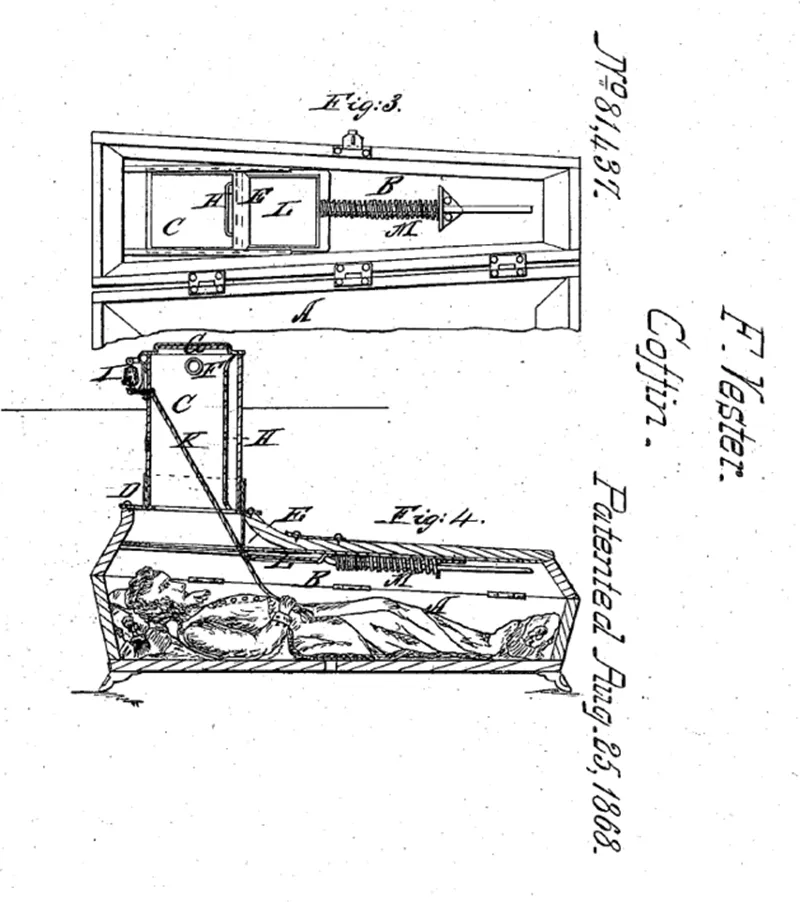
The tomb is equipped with a number of features including an air inlet (F), a ladder (H) and a bell (I) so that the person, upon waking, could save himself. “If too weak to ascend by the ladder, he can ring the bell, giving the desired alarm for help, and thus save himself from premature death by being buried alive,” the patent explains.
Patent No. 268,693 granted on December 5, 1882 to John Krichbaum for a “Device for Indicating Live in Buried Persons”
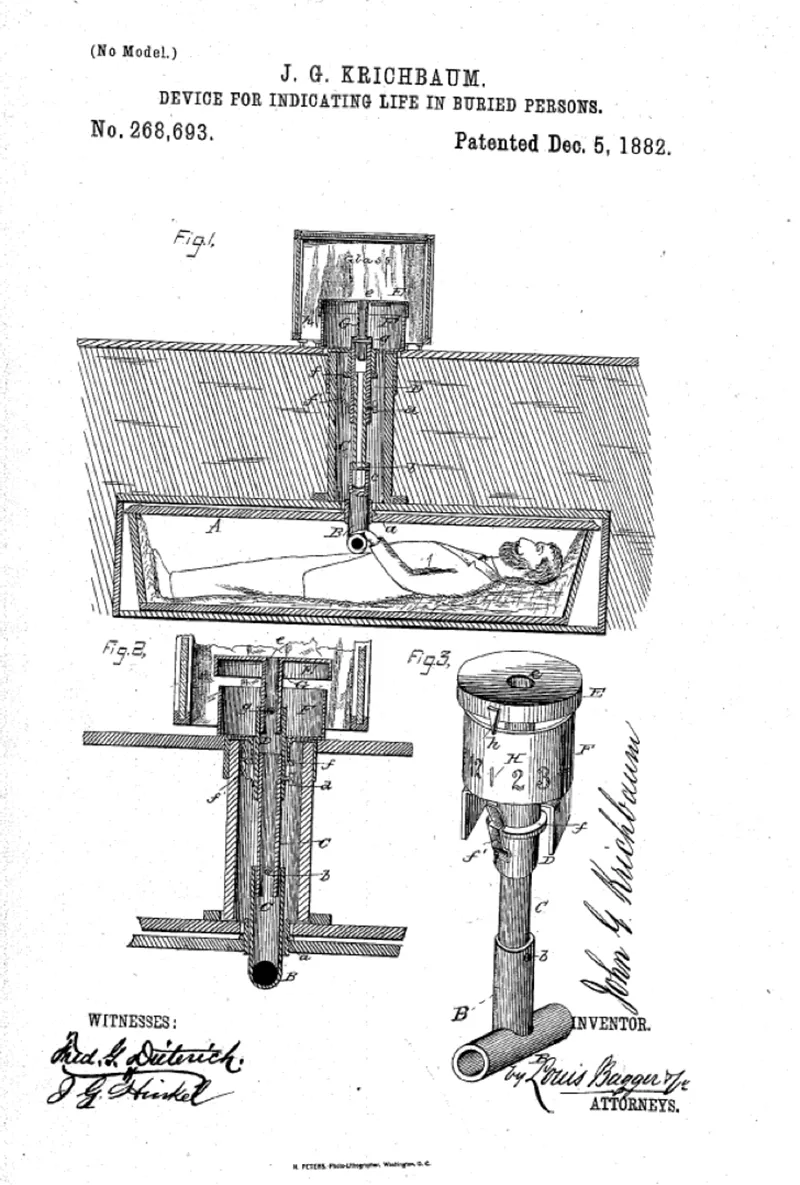
The device has both a means for indicating movement as well as a way of getting fresh air into the coffin. The disclosure states that “It will be seen that if the person buried should come to life a motion of his hands will turn the branches of the T-shaped pipe B, upon or near which his hands are placed.” A marked scale on the side of the top (E) indicates movement of the T, and air passively comes down the pipe. Once sufficient time has passed to assure that the person is dead, the device can be removed.
Patent No. 329,495 granted on November 3, 1885 to Charles Sieler and Fredrerick Borntraeger for a “Burial-Casket”
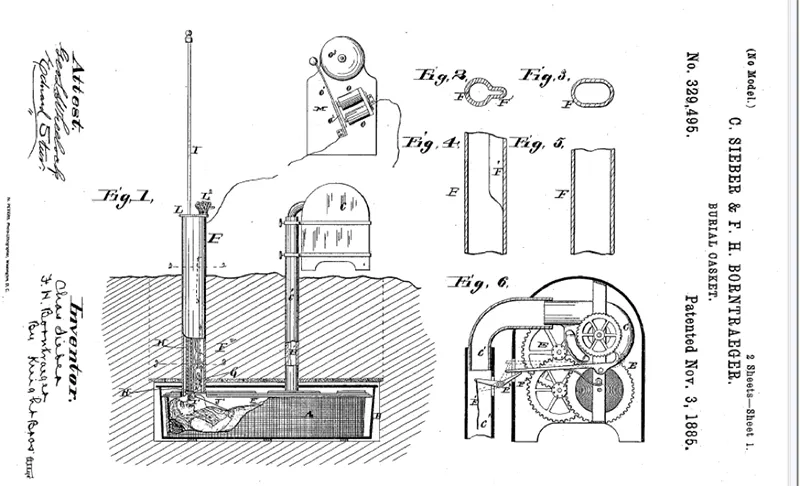
The invention provides for improvements in the important components of previous “burried alive” inventions. In this instance, motion of the body triggers a clockwork-driven fan (Fig. 6), which will force fresh breathable air into the coffin instead of a passive air pipe. The device also includes a battery-powered alarm (M). According to the patent, “When the hand is moved the exposed part of the the wire will come in contact with the body, completing the circuit between the alarm and the ground to the body in the coffin,” the alarm will sound. There is also a spring-loaded rod (I), which will raise up carrying feathers or other signals. Additonally, a tube (E) is positioned over the face of the burried body so that a lamp may be introduced down the tube and “a person looking down through the tube can see the face of the body in the coffin.”
Inventions That Offer Some Comfort to the Living
As medicine has advanced, there have, of course, been technological advances in determining if someone is alive or dead. Doctors can hook up a body to machines that monitor heartbeat, brainwaves and respiration. But even though the fad of coffin alarms has long passed, there are some interesting 21st century innovations in connecting with the dead.
Patent No. 7,765,656 granted August 3, 2010 to Jeff Dannenberg for an “Apparatus and Method for Generating Post-Burial Audio Communications in a Burial Casket”
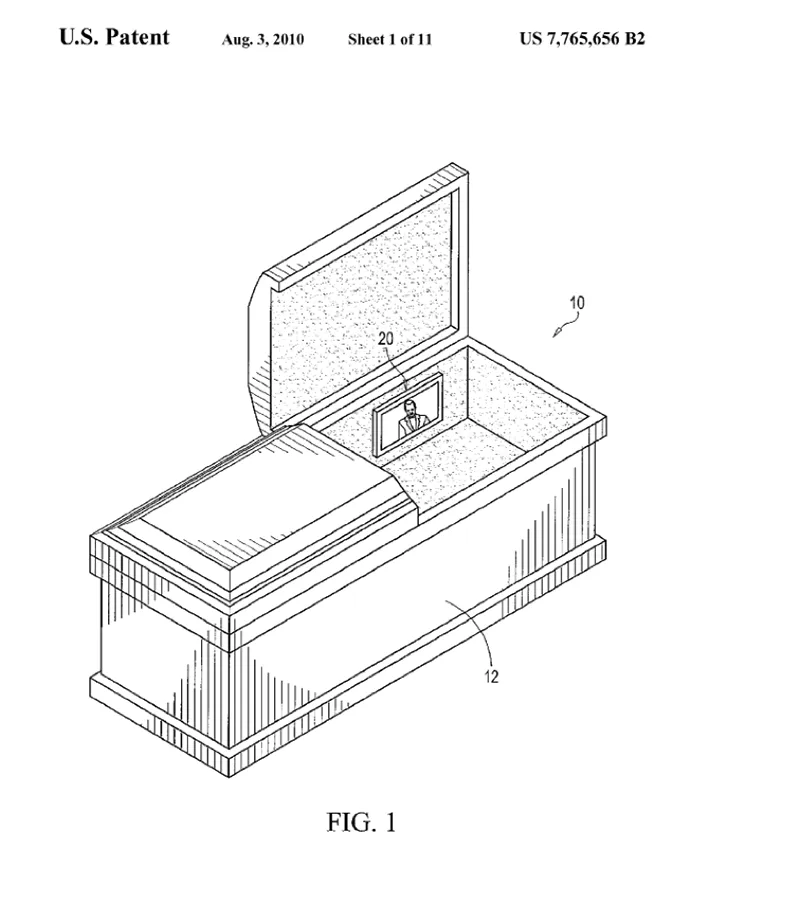
In this instance, the casket has an audio message system (20) containing audio and music files that are automatically played in accordance with a programmed schedule, thereby allowing the living to communicate with the deceased. The system also allows for wireless updating of the recorded files, giving “surviving family members the ability to update, revise and edit stored audio files and programming after burial.”
Patent No. 9,226,059 granted on December 29, 2015 to John Knight for “Your Music for Eternity Systems”
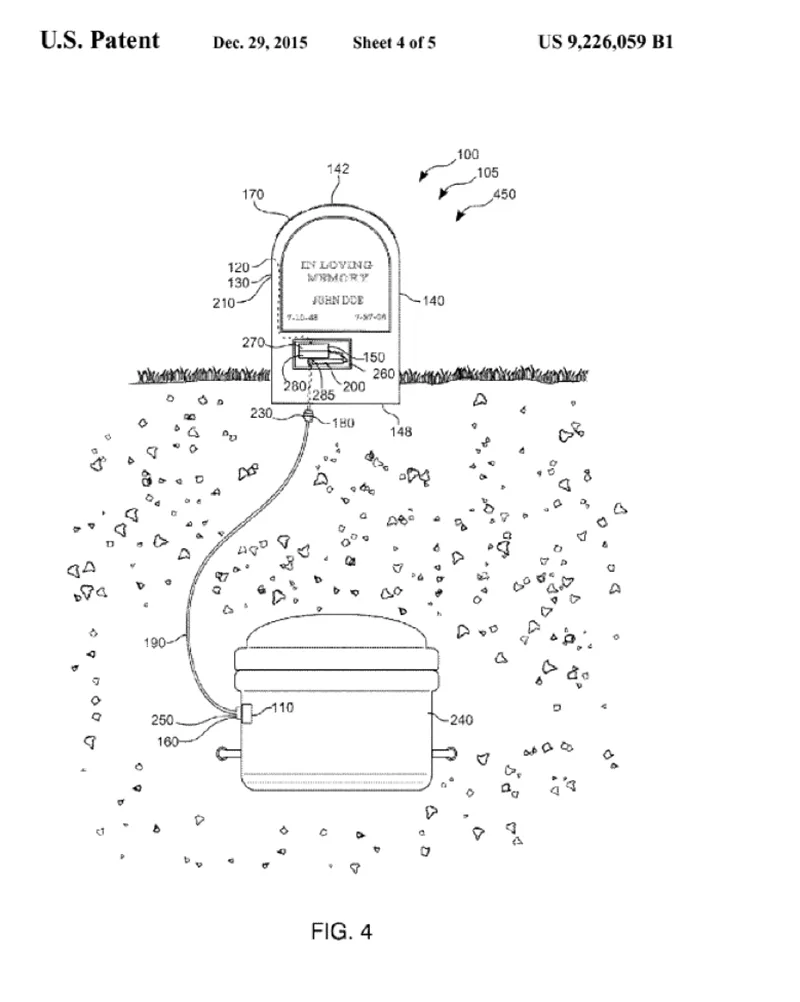
The system comprises a solar powered digital music player, which allows both the living as well as the dearly departed to be comforted by music or a recorded message. There is a speaker in the casket and a headset jack on the headstone.
Patent No. 5,353,609 granted on October 11, 1994 to Ruby Hall for a “Casket Jewelry Guard Apparatus”
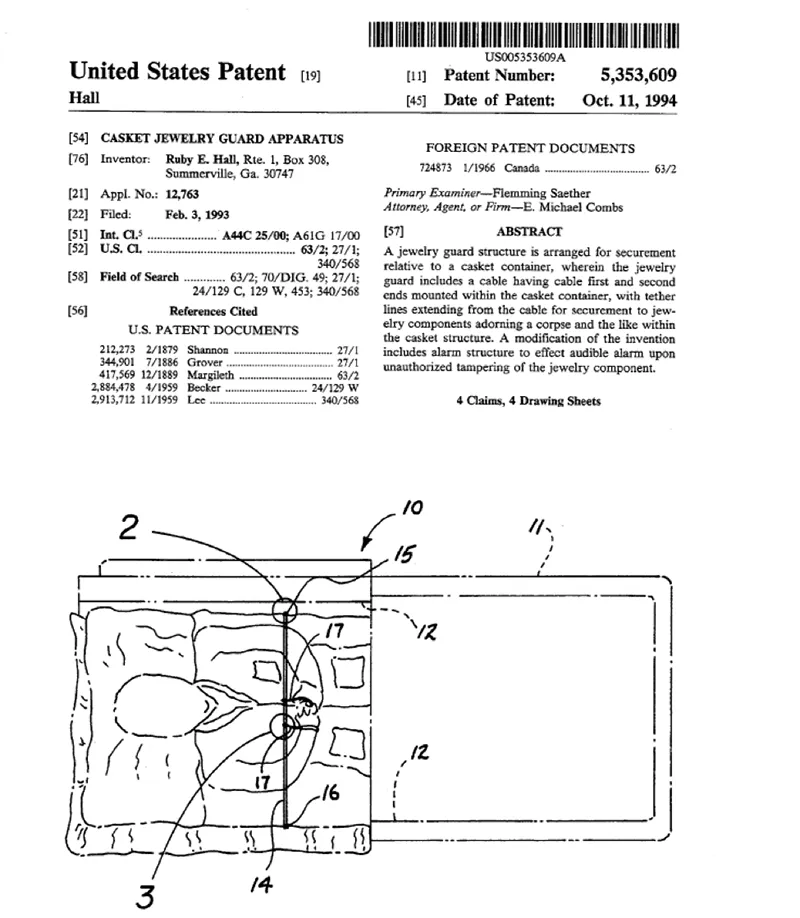
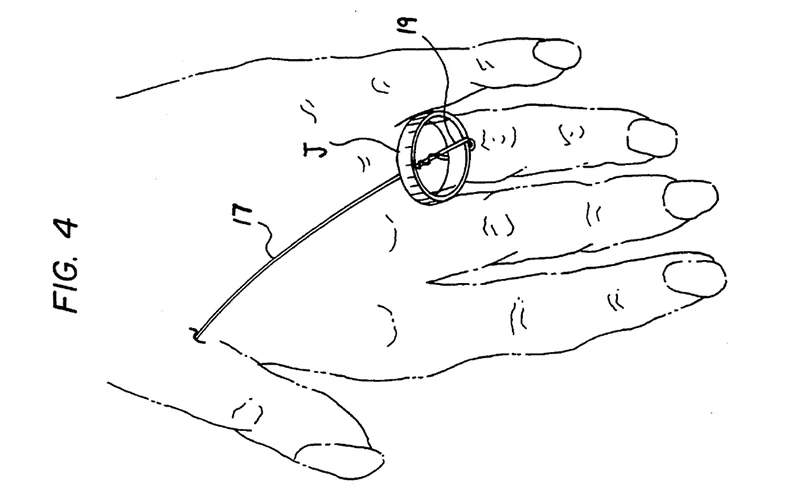
Tomb robbing was recognized as a problem as early as the Early Dynastic Period (c. 3150 - c. 2613 BC), and the living have taken measures to protect the dead and their valuables back to the time of Egyptian Pharaohs. Many of these tombs were equipped with deterrents and safety measures.
This invention, patented in 1994, however, is next level when it comes to protecting the deceased’s valuables. The apparatus attaches the jewelry worn by the deceased to an alarm system while also securing it to the casket. So even after “death do us part,” spouses can wear their wedding rings for eternity.


/https://tf-cmsv2-smithsonianmag-media.s3.amazonaws.com/filer/cd/7d/cd7de9fb-0665-43e6-a9f0-a8fd48bedd4a/coffin-patent.jpg)